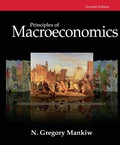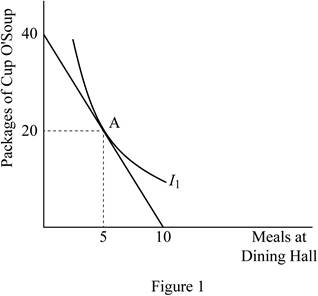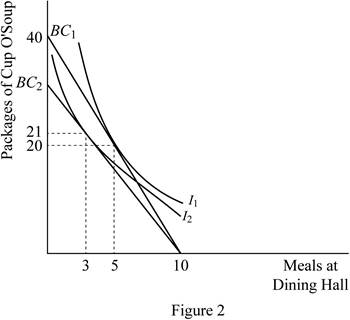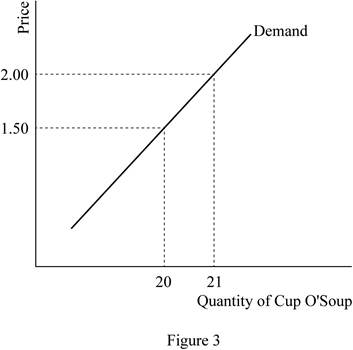
Concept explainers
Subpart (a):
The budget constraint and trade-off.
Subpart (a):
Explanation of Solution
When the wants and needs of a human are unlimited and the budget of an individual is limited, it will lead to a constraint of needs and this constraint raised is due to the limited budget is known as the budget constraint of an individual. Thus, the budget constraint is defined as the possible combination of goods and services that is purchased at a given
Here, the income of the person is given as $60, the price of one meal at dining hall is $6, and the price of cup 'o soup is $1.5. Thus, when the consumer spends her entire income on the meal in dining hall, the quantity that she receives can be calculated by dividing the income by the per meal price as follows:
Thus, when she spends all her income on meal from dining hall, she can buy 10 meals. When she spends all her income on the cup 'o soup meal, the quantity can be calculated by replacing the price of dining hall meal with that of cup 'o soup as follows:
Thus, when she spends all her income on the cup 'o soup meals, she can receive 40 cup 'o soup meals.
The budget constraint represents all the combinations of these two goods ranging between 10 dining hall meals and no cup 'o soup meal to no dining hall meals and 40 cup 'o soup meals. However in this case, the consumer spends her income equally on both of the commodities. Thus, she spends $30 each on dining hall meals and cup 'o soup meals. Thus, when the consumer spends $30 on the meal in dining hall, the quantity that she receives can be calculated by dividing the income by per meal price as follows:
Thus, when she spends $30 of her income on meal from dining hall, she can buy 5 meals. When she spends $30 of her income on the cup 'o soup meal, the quantity can be calculated by replacing the price of dining hall meal with that of cup 'o soup as follows:
Thus, when she spends $30 of her income on the cup 'o soup meals, she can receive 20 cup 'o soup meals. This will be the point of her consumption, when the income is equally spent on both commodities. The graphical representation shows this combination at point A and it is represented as follows:

Concept introduction:
Budget constraint: Budget constraint is defined as the possible combination of goods and services that is purchased at a given price level with the entire income.
Normal good: The goods whose quantity demanded increases, when the income of the consumer increases and vice versa.
Inferior good: The goods whose quantity demanded falls, when the income of the consumer increases and vice versa.
Giffen goods: They are the special cases of inferior goods in which an income effect overweighs the substitution effect.
Subpart (b):
The budget constraint and trade-off.
Subpart (b):
Explanation of Solution
When the price of the cup o' soup increases to $2 from $1.5, the vertical intercept of the student's budget constraint will shift downwards; this will flatten the budget constraint curve. When she spends all her income on the cup 'o soup meal, the quantity can be calculated by replacing the price of dining hall meal with that of cup 'o soup as follows:
Thus, when she spends all her income on the cup 'o soup meals, she can only receive 30 cup 'o soup meals. This flattens the budget constraint curve.
It is also said that at present she only spends 30 percent of her income on the dining hall meal, which means that the income spent on dining hall meal is only $18 and that spend on cup o' soup is $42. At this income spending distribution, she can purchase 3 units of dining hall meals and 21 units of cup o' soup meals. This new point can be illustrated as point B and it can be represented as follows:

Concept introduction:
Budget constraint: Budget constraint is defined as the possible combination of goods and services that is purchased at a given price level with the entire income.
Normal good: The goods whose quantity demanded increases, when the income of the consumer increases and vice versa.
Inferior good: The goods whose quantity demanded falls, when the income of the consumer increases and vice versa.
Giffen goods: They are the special cases of inferior goods in which an income effect overweighs the substitution effect.
Subpart (c):
The budget constraint and trade-off.
Subpart (c):
Explanation of Solution
The initial price of cup o' soup was $1.5, and the new price after the increase is $2. The initial quantity demanded of cup o' soup was 20 units; whereas after the increased price of the commodity, the quantity demanded is 21 units. This shows that the
Concept introduction:
Budget constraint: Budget constraint is defined as the possible combination of goods and services that is purchased at a given price level with the entire income.
Normal good: The goods whose quantity demanded increases, when the income of the consumer increases and vice versa.
Inferior good: The goods whose quantity demanded falls, when the income of the consumer increases and vice versa.
Giffen goods: They are the special cases of inferior goods in which an income effect overweighs the substitution effect.
Subpart (d):
The budget constraint and trade-off.
Subpart (d):
Explanation of Solution
The initial price of cup o' soup was $1.5, and the new price after the increase is $2. The initial quantity demanded of cup o' soup was 20 units denoted by point A; whereas after the increased price of the commodity, the quantity demanded is 21 units denoted by point B. This shows that the demand for the commodity will increase, when the price of the commodity increases. Thus, these two points can be graphically illustrated as follows:

Here, the demand for the cup o' soup increases, when its price increases, which means that the commodity is an inferior good. However at the same time, the income effect overweighs the substitution effect for the commodity, which is a special case of inferior goods, known as the Giffen goods. Thus, the cup o' soup is a Giffen good.
Concept introduction:
Budget constraint: Budget constraint is defined as the possible combination of goods and services that is purchased at a given price level with the entire income.
Normal good: The goods whose quantity demanded increases, when the income of the consumer increases and vice versa.
Inferior good: The goods whose quantity demanded falls, when the income of the consumer increases and vice versa.
Giffen goods: They are the special cases of inferior goods in which an income effect overweighs the substitution effect.
Want to see more full solutions like this?
Chapter 21 Solutions
EBK STUDY GUIDE FOR MANKIW'S PRINCIPLES
- How does the mining industry in canada contribute to the Canadian economy? Describe why your industry is so important to the Canadian economy What would happen if your industry disappeared, or suffered significant layoffs?arrow_forwardWhat is already being done to make mining in canada more sustainable? What efforts are being made in order to make mining more sustainable?arrow_forwardWhat are the environmental challenges the canadian mining industry face? Discuss current challenges that mining faces with regard to the environmentarrow_forward
- What sustainability efforts have been put forth in the mining industry in canada Are your industry’s resources renewable or non-renewable? How do you know? Describe your industry’s reclamation processarrow_forwardHow does oligopolies practice non-price competition in South Africa?arrow_forwardWhat are the advantages and disadvantages of oligopolies on the consumers, businesses and the economy as a whole?arrow_forward
- 1. After the reopening of borders with mainland China following the COVID-19 lockdown, residents living near the border now have the option to shop for food on either side. In Hong Kong, the cost of food is at its listed price, while across the border in mainland China, the price is only half that of Hong Kong's. A recent report indicates a decline in food sales in Hong Kong post-reopening. ** Diagrams need not be to scale; Focus on accurately representing the relevant concepts and relationships rather than the exact proportions. (a) Using a diagram, explain why Hong Kong's food sales might have dropped after the border reopening. Assume that consumers are indifferent between purchasing food in Hong Kong or mainland China, and therefore, their indifference curves have a slope of one like below. Additionally, consider that there are no transport costs and the daily food budget for consumers is identical whether they shop in Hong Kong or mainland China. I 3. 14 (b) In response to the…arrow_forward2. Health Food Company is a well-known global brand that specializes in healthy and organic food products. One of their main products is organic chicken, which they source from small farmers in the area. Health Food Company is the sole buyer of organic chicken in the market. (a) In the context of the organic chicken industry, what type of market structure is Health Food Company operating in? (b) Using a diagram, explain how the identified market structure affects the input pricing and output decisions of Health Food Company. Specifically, include the relevant curves and any key points such as the profit-maximizing price and quantity. () (c) How can encouraging small chicken farmers to form bargaining associations help improve their trade terms? Explain how this works by drawing on the graph in answer (b) to illustrate your answer.arrow_forward2. Suppose that a farmer has two ways to produce his crop. He can use a low-polluting technology with the marginal cost curve MCL or a high polluting technology with the marginal cost curve MCH. If the farmer uses the high-polluting technology, for each unit of quantity produced, one unit of pollution is also produced. Pollution causes pollution damages that are valued at $E per unit. The good produced can be sold in the market for $P per unit. P 1 MCH 0 Q₁ MCL Q2 E a. b. C. If there are no restrictions on the firm's choices, which technology will the farmer use and what quantity will he produce? Explain, referring to the area identified in the figure Given your response in part a, is it socially efficient for there to be no restriction on production? Explain, referring to the area identified in the figure If the government restricts production to Q1, what technology would the farmer choose? Would a socially efficient outcome be achieved? Explain, referring to the area identified in…arrow_forward
- I need help in seeing how these are the answers. If you could please write down your steps so I can see how it's done please.arrow_forwardSuppose that a random sample of 216 twenty-year-old men is selected from a population and that their heights and weights are recorded. A regression of weight on height yields Weight = (-107.3628) + 4.2552 x Height, R2 = 0.875, SER = 11.0160 (2.3220) (0.3348) where Weight is measured in pounds and Height is measured in inches. A man has a late growth spurt and grows 1.6200 inches over the course of a year. Construct a confidence interval of 90% for the person's weight gain. The 90% confidence interval for the person's weight gain is ( ☐ ☐) (in pounds). (Round your responses to two decimal places.)arrow_forwardSuppose that (Y, X) satisfy the assumptions specified here. A random sample of n = 498 is drawn and yields Ŷ= 6.47 + 5.66X, R2 = 0.83, SER = 5.3 (3.7) (3.4) Where the numbers in parentheses are the standard errors of the estimated coefficients B₁ = 6.47 and B₁ = 5.66 respectively. Suppose you wanted to test that B₁ is zero at the 5% level. That is, Ho: B₁ = 0 vs. H₁: B₁ #0 Report the t-statistic and p-value for this test. Definition The t-statistic is (Round your response to two decimal places) ☑ The Least Squares Assumptions Y=Bo+B₁X+u, i = 1,..., n, where 1. The error term u; has conditional mean zero given X;: E (u;|X;) = 0; 2. (Y;, X¡), i = 1,..., n, are independent and identically distributed (i.i.d.) draws from i their joint distribution; and 3. Large outliers are unlikely: X; and Y, have nonzero finite fourth moments.arrow_forward

 Economics (MindTap Course List)EconomicsISBN:9781337617383Author:Roger A. ArnoldPublisher:Cengage Learning
Economics (MindTap Course List)EconomicsISBN:9781337617383Author:Roger A. ArnoldPublisher:Cengage Learning

 Exploring EconomicsEconomicsISBN:9781544336329Author:Robert L. SextonPublisher:SAGE Publications, Inc
Exploring EconomicsEconomicsISBN:9781544336329Author:Robert L. SextonPublisher:SAGE Publications, Inc Principles of Microeconomics (MindTap Course List)EconomicsISBN:9781305971493Author:N. Gregory MankiwPublisher:Cengage Learning
Principles of Microeconomics (MindTap Course List)EconomicsISBN:9781305971493Author:N. Gregory MankiwPublisher:Cengage Learning





